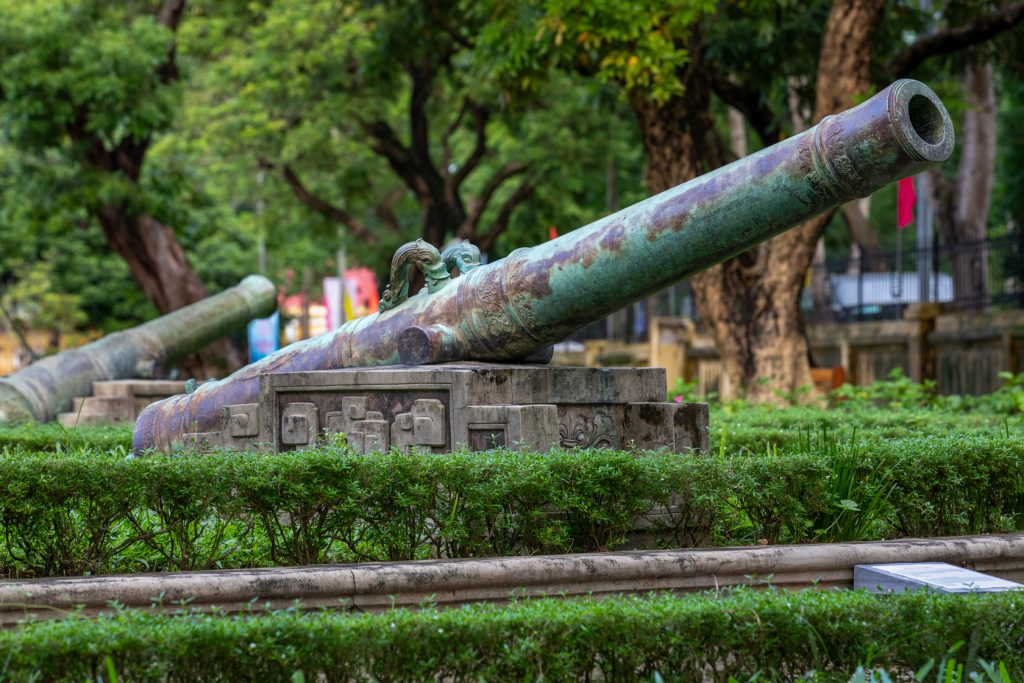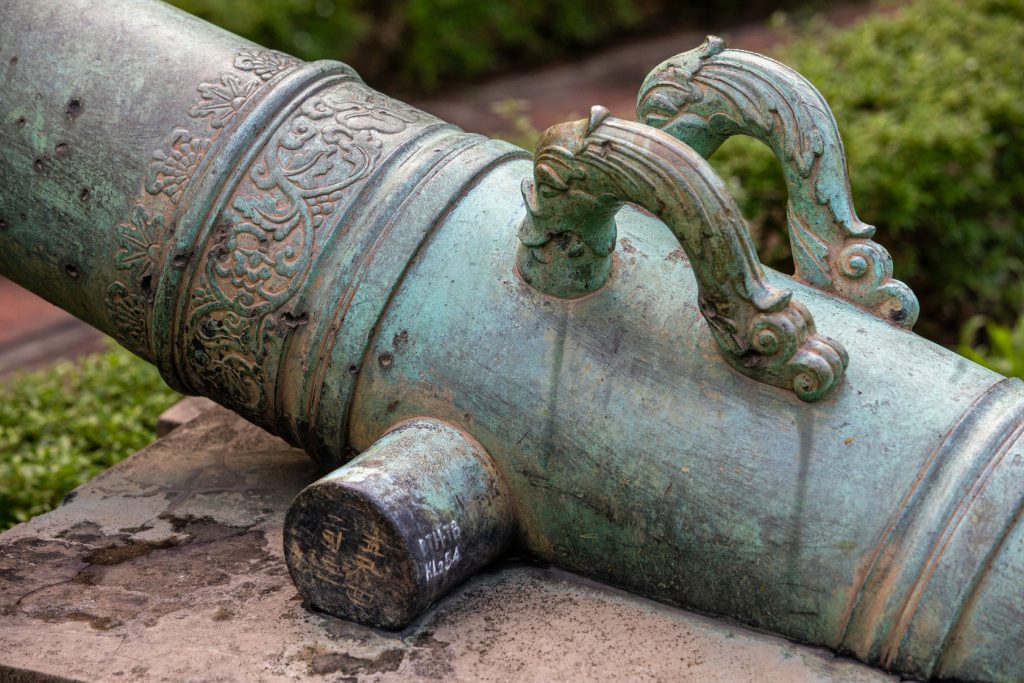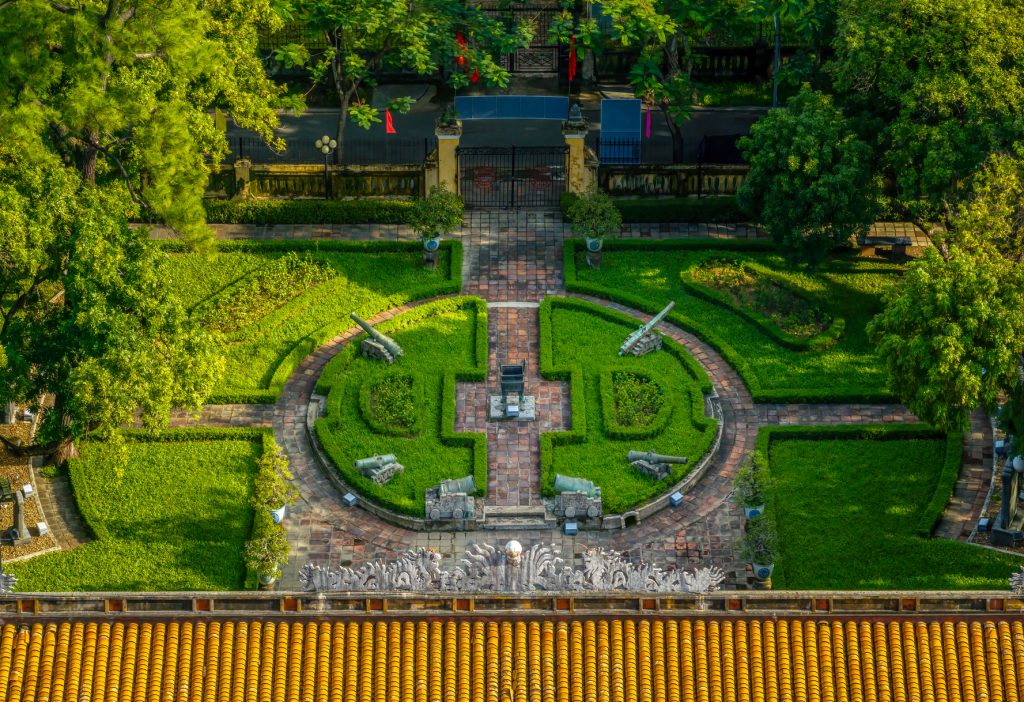Story: Phan Thanh Hai
Photos: Nguyen Phong
Having survived over 300 years of tumultuous history, these majestic cannons have turned green with time, adding to their ancient and mysterious beauty.

Three exquisitely crafted and well-preserved bronze cannons made in the Netherlands are on display in the Hue Royal Antiquities Museum. Having survived over 300 years of tumultuous history, these majestic cannons have turned green with time, adding to their ancient and mysterious beauty. Learning about the origins of these cannons, one cannot help but admire the extraordinary skills of the craftsmen who cast them, and also marvel at the destiny that brought these ancient Western cannons to Vietnam.
According to historical documents, at the beginning of the 15th century, a Vietnamese man invented the technique of casting cannons. This man was Ho Nguyen Trung, the eldest son of Ho Quy Ly. Despite being a defeated prisoner of war who was transported to Beijing, Ho Nguyen Trung was highly valued by the Ming Dynasty. Appointed the Minister of Works, he was referred to as “Hỏa khí chi thần” (Master of Fire Weapons). Losing this genius led to the loss of cannon-casting techniques in Vietnam. Meanwhile, from the 16th century onwards, Western countries made significant advances in their cannon-casting techniques. The Netherlands was a powerhouse in terms of this technology. In the 16th and 17th centuries, Dutch cannons were exported around the world by the Vereenigde Oost-Indische Compagnie (VOC), including to the Vietnamese market.

Interestingly, all three of the Dutch cannons in the Hue Royal Antiquities Museum were either gifts or goods traded by Lord Trinh, not the spoils of war or goods traded by the Nguyen lords in Inner Annam (Đàng Trong), yet they all ended up in the capital of the Nguyen Dynasty. Currently, they are registered with the numbers: BTH-TB KL2 52, BTH-TB KL2 53, and BTH-TB KL2 54. All three are displayed in the front yard of the museum.
French-Vietnamese researcher Philippe Truong meticulously researched the origins of these three cannons. According to Mr. Truong, the first cannon (BTH-TB KL2 52) was cast by Gerard Koster (1627 – 1679), a famous craftsman in Amsterdam in 1661. This cannon is 207 cm long, with a 10 cm diameter at the muzzle, and weighs 1,364 livres (approximately 682 kg). The rim of the cannon’s breech is inscribed with “GERARD KOSTER ME FECIT AMSTELREDAMI A° 1661”. The top and side of the cannon’s wedge are inscribed with additional Chinese characters: 四尺八二寸二 (length four feet, eighty-two inches, two centimeters). The cannon’s barrel is cylindrical, consisting of three parts: the chase, the reinforce, and the breech. The breech is large, tapering towards the chase, with a flared muzzle. There are two stylized handles on the upper barrel of the cannon, shaped like two dolphins, with their beaks and tails attached to the barrel. The end of the breech features a cone-shaped knob with oak leaf patterns, typical of 17th-century Dutch cannon design. The barrel is adorned with an oak leaf vine, a sailing ship, and the letters A and VOC. The image of a three-masted sailing ship flying the Dutch flag on this cannon is representative of the type of merchant ship used by the Vereenigde Oost-Indische Compagnie to trade between the Netherlands and Southeast Asia. This image also symbolizes the company, and was often depicted on the seals of its governors. The decorative style indicates that this cannon was specifically cast for an important ship of the Vereenigde Oost-Indische Compagnie.

The second cannon (BTH-TB KL2 53) is 197 cm long, with a muzzle diameter of 10 cm, and weighs 1,355 livres (approximately 677.5 kg). It was cast by Kylianus Wegewaert, a renowned artisan, in Kampen in 1640. The cannon’s breech rim is inscribed with “KYLIANUS. WEGEWART. ME. FECIT. CAMP. 15. A°”. The top and side of the cannon’s wedge feature the Chinese characters: 四 尺 六 二 寸 三 (length four feet, sixty-two inches, and three centimeters). The decoration on the cannon’s barrel is rich and intricate, featuring stylized oak leaves and repeated flowers and foliage, as well as bizarre human mask motifs, characteristic of European decorative styles in the early 17th century. Surprisingly, it also features a design of laurel wreaths encircling the motif “Two Dragons Fighting for a Pearl”, a decoration not previously seen in the Netherlands at that time. According to Mr. Truong, a researcher and collector of antiques, this cannon was likely a gift from the Vereenigde Oost-Indische Compagnie to Lord Trinh to curry favor with the government of Outer Annam (Đàng Ngoài).
The third cannon (BTH-TB KL2 54) does not bear the name of its maker or the year it was made. On its wedge, seven Chinese characters were inscribed: 五 尺 四 二 寸 三 一 (length five feet, forty-two inches, thirty-one centimeters). The decorative motifs on the barrel are typical of Vietnam at that time, featuring patterns such as chrysanthemums, persimmons, and repeated apricot blossom motifs. The rear part of the cannon features a raised lotus flower within a stylized oval, resembling a bud, a type of decoration mimicking European motifs. The casting technique and copper used to make this cannon are inferior to the two cannons cast in 1640 and 1661. This was likely one of the six cannons ordered by Lord Trinh Tac (1606 – 1686) from the Vereenigde Oost-Indische Compagnie through the Dutch trading post in Ke Cho – as Hanoi was popularly called. This cannon was cast around 1677 – 1678. In May 1678, the ships Experiment and Croonogel docked in Outer Annam to deliver these cannons to Lord Trinh. Being custom-ordered, the decorations on this cannon’s barrel bear the cultural characteristics of the Le Trung Hung period.
These three Dutch-made copper cannons each have their own unique beauty and hold special historical value. After the unification of the country, Emperor Gia Long must have brought them to the capital Hue, using them as models for research and subsequently casting thousands of cannons for the dynasty. After 1885, the French displayed these cannons at the Office of the French Resident Superior in Annam. They were donated to the Khai Dinh Museum (Musée Khai Dinh), established exactly 100 years ago, where they have been preserved to this day.










